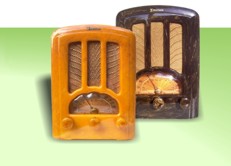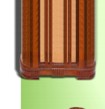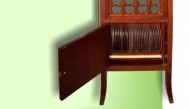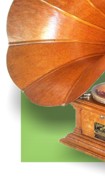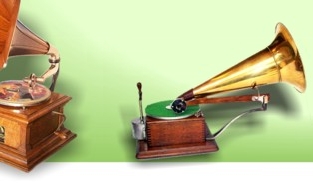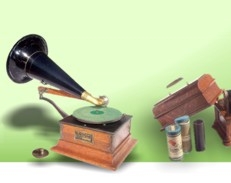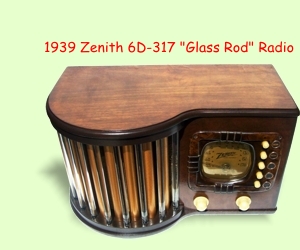|
In a Nutshell
An all-original Expert Junior acoustic gramophone, hand-made by Michael Ginn in 1933, three years after the big schism from his former company E.M.G. and when just again moving to new premises

Notes added Aug. 27, 2014:
1. A new red rubber sound-box flange, expertly made by Chunny Bhamra has been installed on Aug. 21, 2014 (pict.s 62, 63)
2. A sound-box for vertically cut records (Pathé and Edison) has been taken from a Duovox tone-arm, made by Bush & Lane in 1923, and used to have the gramophone playing a center-start 14" Pathé record (2026, 82998-ER, 636) "Près Du Jardin", sung in 1912 by French opera tenor Albert Désiré Vaguet, as well as the Edison Diamond Disc 51281-R "Dream Daddy", recorded 1923 by the California Entertainers. Pictures 64-69 have been added and a new youtube video (ref.8 or click on thumbnail 79) has been uploaded
Notes added Nov.6, 2014:
1. A theoretical note on tracking errors, distortions etc. for the Expert Junior has been added (see For the perfectionists only, below), and pict.s 70-74)
2. A fourth youtube video has been published, with the gramophone playing Gustav Mahlers second of four "Lieder eines fahrenden Gesellen" sung by contralto Carol Brice in 1947 (Columbia MX-267, pict.76). The movie was taken with my new Canon Rebel T5i, where the microphone's volume was manually set constant in order to avoid noise amplified by AVC (ref.9 or click on thumbnail 80)
3. A Wade & Wade fibre needle cutter ("The Wade") in original (worn) box has been purchased and will be included in the sale (pict.75)
Introduction:
The most competent and refreshing account of what E.M.G. (ref.1) is all about, can be found in Francis James' 1998 book "The E.M.G. Story" (ref.2), from which some of the following information was condensed. After WWI, Ellis Michael Ginn [1899-1959], under strong influence of his musical wife Esther and her brother David Phillips, decided not to turn into a farmer, but to bless the world with the best quality gramophone one could imagine. Gramophones were mass-produced at the time, but a lot was left to be desired, especially by gramophiles, who wanted highest possible fidelity for their new electrically recorded 78's, containing in particular serious classical music. E.M.G.'s gramophones were hand-made, very affordable though, and did well, so well that Michael could buy a new house and have it filled with furniture, hand-made by his own gramophone cabinet workshop, thus slowing down gramophone production. A mutiny by his staff forced him out of his own company, to even leave his name behind, and in 1930 to start all-over again at a new location, with a new name "Expert", but together with his old friend and brother-in-law Dave Phillips. Michaels own interpretation of the big schism is very well documented in a 1933 37-page Expert brochure, available on-line (ref.3 and pict.59), in which he doesn't mince matters about every thing non-Expert. In fierce competition with EMG and its new director Balfour Davey, Ginn started building the "Expert" models Senior, Junior, and Minor with increasing success, all three being rated as the finest ever hand-made acoustic gramophones and believed to outperform even Davey's "Mark" series - with an incredible sound, that can only be taken in by sitting in front of one of their humongous horns (pict.10). The Junior presented here is 3 feet 8 inches tall, including the 2 feet wide horn made from paper appliquée.
All parts of the gramophone reveal the minds and hands of the many experts who helped Ginn in creating and selling his dream machines: Henry Seymour, Percy Wilson, David Phillips, Balfour Davey, Christopher Collaro and others. The turntable ensemble was patented and made by Collaro and includes an electric induction motor, whereas most Experts were sold with a Collaro D30 hand-crank motor. The spring barrel part is upgraded by a 4-pole induction motor, whereas speed is regulated by a conventional governor. Conventional - yes - but highly sophisticated, optimized and solidly built in detail, with a single central coil spring instead of the common three leaf springs (pict.38). The aorta of the gramophone is the tone-arm (pict.41) with its double ball bearing pivot hinge and a "Quincke Tube" adjustable air chamber at the dead end opposing the goose-neck sound-box adapter, eventually canceling out resonances from the sound-box diaphragm, as Moore and Wilson discuss in ref.4. The total acoustic length of the gramophone (20" tone-arm, 34" horn bracket, 59" horn) is a remarkable 9½ feet, a number favoured by Wilson's theoretical calculations. The heart of the gramophone is the sound-box, here the all-brass half-a-pound heavy Expert four-spring soundbox (pict.s 43-51), the paragon of perfection achieved by Ginn's EMG and Expert engineers, that is especially adapted to play with thorn and fibre needles.
Additional information:
ref. 1: http://en.wikipedia.org/wiki/E.M.G._Hand-Made_Gramophones
ref. 2: Francis James, The E.M.G. Story, Old Bakehouse Publications, London 1998, ISBN: 1 874538 27 1
ref. 3: http://forum.talkingmachine.info/viewtopic.php?f=11&t=12196 and http://forum.talkingmachine.info/viewtopic.php?f=11&t=12195
ref. 4: F. C. Moore, The Perfect Gramophone, The Gramophone, Sept. 1923, with notes by Percy Wilson
ref. 5: http://mtr.arcade-museum.com/MTR-1919-69-24/MTR-1919-69-24-147.pdf
ref. 6: http://youtu.be/yX0gVsy4Fdc
ref. 7: http://youtu.be/q7e6RSZdSi8
ref. 8: http://youtu.be/cWYlwOG_iaQ
ref. 9: http://youtu.be/TFqHf5eCHpk
ref.10: Percy Wilson, "Needle Track Alignment" The Gramophone, September (pp.129–131) and October (pp.167–169) 1924
ref.11: http://www.diyaudio.rs/index.php?app=core&module=attach§ion=attach&attach_id=2785
http://www.stereophile.com/reference/arc_angles_optimizing_tonearm_geometry/index.html
About my Expert Junior:
The gramophone came to me with an ugly, very dark almost black cellulose sprayed finish, that had scratches, got very brittle and would be easy to scratch even further with a finger nail, a very well documented deficiency of these gramophones, that have been built during the worst recession of all times. It was missing the 4 feet, that however left a very clear imprint as to their size (2 ½" square). I have no idea why the feet had been removed (it may have been connected to a record cabinet stand?), but the result was that the bottom edges had a little veneer edge wear that needed restoration. After discussions with several Expert experts I decided to not reveneer the cabinet, but to only strip it, restain in light brown and finish it with the very robust Varathane semi-gloss water based Diamond clear coat. The new feet are simple cuboids, with a full-size felt shock absorber underneath. The result looks very similar to most cabinets I found documented on the net, and resembles the earlier French polish used for solid oak. All other parts of the gramophone are in original, working and even serviced condition, including the large size red gaskets of the sound-box. The cabinet had two holes, one for the power cord in the back, and one left of the keyhole in the front. There is no indication of a hole on the right side, which would signal an after-market conversion of the gramophone from wind-up to electric. There was also an extra hole in the turntable board with two screw holes, that may indicate the former presence of a mechanical spring motor brake. Ginn's gramophones were not only hand-made but also custom-made, and there are dozens of variations. Moreover both Ginn companies were actively advertizing their readiness to convert gramophones according to customer's wishes. I closed both unused holes (pict.21).
The horn is in exceptionally mint condition, having needed only miniscule touch-up care on its original gold-brown finish. Unlike EMG horns, Expert horns had a metal insert at their vertical-to-horizontal transition, preventing the horn to sag too much. My horn has only sagged to about 80 degrees (from 90), just right to let the sound come down from the gramophone sitting on a table to a seated audience. Since completion of my restoration I did a few demonstrations of the gramophone in my home, as Michael himself did in his audio rooms from his very beginnings in Brighton to the later concert evenings at Café Marguerite. Like Michael I heard my guests wondering in disbelief: This is a 78? - Oh, my God, this is unreal! - Where's the noise gone? - What is the power of the amplifier? - ... You may get at least a pale intimation of its superb performance by watching my two youtube videos (ref.s 6 and 7, or click on thumbnail 70 and 71). Please
e-mail me (Kris) for any questions, ich spreche Deutsch, je parle Français.
For the historians only:
My machine can be quite accurately dated, despite non-existant serial numbers on Expert gramophones, thanks to the very rare ivorine tag (pict.24), showing two different addresses for the company. In June 1933 Ginn moved from his initial 1930 premises at 55 Rathbone Place, which is at the east corner intersection with Oxford Street, to the vacant and cheaper top floor at 10A Soho Place, the home of "The Gramophone" magazine, where he would stay for the next 3 years, almost unapproachable due to the many stairs, to be conquered by his wealthy clients. The same two addresses are also found on a brochure about Expert products (ref.3), that allowed the publisher to date it to the same year 1933.
Minuscule details like this often also lead to quite amusing pleasure trips into history. This time the trigger was a mysterious 1/8" weeny monogram I found on the lid support of the gramophone (pict.28), a "P", an "L" and possibly a "C"? Googling the patent number I found that the inventor of this very useful one-hand lid support, Joseph Alfred Stone was an assignor for a "Pianoforte Supplies Ltd." company, that made metal parts for pianos in London and Roade. The proof, that the monogram is in fact a "P", an inverted "S" and an "L" came from a bowling club pin badge that shows a very similar crest. The company was founded in 1923 by Cyril Thomas Cripps, who expanded it steadily to produce parts for the car industry and during the war WWII armament. Cripps and his son Cyril Humphrey were knighted in 1989 for their extreme philanthropy, the Cripps foundation donating large sums to universities, colleges, schools, churches, hospitals and museums. Residences at many British colleges bear the Cripps name. Sir Humphrey was also a vivid stamp collector and custodian of the Chartwell Collection, that contained the Mauritius 'Post Office' 2d stamp, sold in 2011 for £1.08M, 37 times more than he had payed for in 1972. There is something mysterious about the rest of the story: Cripps' Pianoforte company in its 1960's heyday employed up to 2000 people working in their many, with big machinery equipped halls in Roade. In less than 10 years the personnel declined rapidly and from the seventies on the premises started to decompose and getting a disposal problem for the village. For a long time they were a popular destination for Sunday outings and a paradise for ghost town photographers and photo backdrop hunters. How is it possible that a company that is known to have built affordable housing for their staff and provided everything from pension plans to bowling clubs for them, found such a deplorable end? At the same time Sir Humphrey, together with his two sons Edward J(ames) S(pencer) Cripps [1951-2009] and Robert W(inston) H(umphrey) Cripps [born 1946] expanded business to the Netherlands Antilles (Velcro, the "zipperless zipper"), Bermuda, British Virgin Islands, Canada,... and bought new land in Roade. Philanthropy didn't stop though, as exemplified as recently as April this year, when the Cripps foundation donated $6.9M to the University of Melbourne to support art conservation. So much amazing history from a little 1/8" monogram PSL on the lid support of a 1933 gramophone!
For the techies only:
78 rpm gramophone records are mostly played with steel needles. Since they are quite soft they wear off quite rapidly, often already after playing only one record side. Playing a second record side with the same now sharply pointed needle risks to damage this side's grooves, especially once the needle has been taken out and reinserted into the reproducer. Hence the rule "one record side per needle". It was Frederick D. Hall in Chicago who in 1907 invented, patented and later mass-produced needles (125-180 per minute) from bamboo stems to replace steel needles (ref.5). They wear off too, but don't harm record grooves, and can be repointed about 10 times. Also cactus thorns make good styli, I even was able to play a whole record side with a blackberry thorn (ref.6). Fibre needles are cheap and easy to make (pict.s 55,56), but miss to reproduce the very high frequencies and therefore produce a mellow timbre, inadequate for certain dramatic sections with a large dynamic range or for entire compositions like for example the Firebird Suite by Igor Strawinski (ref.7). I have very good experience with sapphire tipped metal needles, that are pointed to 3 mil with the help of diamonds (pict.57). They don't wear off and therefore can play many record sides. The Expert sound-box weighs half a pound - by purpose - to increase its inertial mass, which unfortunately however is the same as its gravitational mass, which in turn fixes the pressure of the stylus on the record. The best way to reduce this pressure, is to install an adjustable sound-box counterweight (which even further increases the inertial mass), or to take the gramophone with you on your next trip to the International Space Station. Counterweights have been proposed, designed, home-made and commercially produced by many people, including Michaels son Joe. Pict.60 shows one of my own proposals.
For the perfectionists only:
Any needle attached to a cartridge, that is not mounted on a tangential (linear tracking) tonearm, exhibits forces on the lateral walls of the tracks of a record, which in turn introduces non-linear distortions in its reproduction and causes record wear. This is especially true for mechanical (acoustic) soundboxes, as was first observed by Percy Wilson (ref.10). Subsequently the subject was followed up in many more theoretical articles treating these tracking errors and distortions and their optimization (ref.11). A tangential tonearm by definition and by construction makes sure that the force generated by the friction between needle and grove is directed always tangential to the groove's spiral for the entire length of a record. A pivoted tonearm by definition cannot be adjusted to provide the same match, except for two points along the trajectory of the needle from outer to inner recording radius. The nomenclature is explained in pict.70 for the Expert Junior, the numerical values are approximate, since I did not use a Wilson alignment protractor. Given by construction are the distance between pivot point and turntable center (spindle) [l-d=297mm], and the cartridge offset angle [Φ=18º], whereas the effective tonearm length [l=310mm] and with it the overhang [d=13mm] are to some extent dependent on the stylus angle [α=60º], that can be adjusted by rotating the soundbox around its own pivot point, as shown in pict.71, and is recommended to be around 60º. Obviously also the stylus length directly influences l and d. These dependences are rarely discussed in literature, but turn out as we will see later, to be of greatest importance and are the main subject of this note. Pict.72 shows the ideal tracking angle as a function of the radial distance between needle contact and record center [r]. Also indicated are the sizes of three popular record formats: a 10" diameter, a 12" diameter record and a 14" diameter "small" Pathé record. The two points where the ideal tracking angle matches the actual one of 18º are at radii of 13.2cm (about ½" after start of a 12" record) and 5.9cm (shortly before the end of all records). The largest tracking angle error of 1.4º occurs at 9cm (in the middle of a 10" or 12" record), but can go up to 2.4º at the beginning of a 14" Pathé record. Distortions are suppressed by an additional 1/r dependence, caused by the increased needle speed at larger radii, and nowhere exceed 0.6 to 0.7%. Compare this to a "mass-produced" Victor or Columbia gramophone (the Victor II is the worst in this respect), where tracking errors of up to 12º are encountered. The extreme sensitivity of the tracking error on the overhang can already be seen in this picture, by comparing the blue with the violet curves, that differ by an overhang difference of only 2 mm. Pict.73 shows the dependence of the optimal tracking angle and overhang of the Expert Junior as a function of x (the ratio of usable outer to inner track radii) and y (the ratio of inner track radius to tonearm length, fixed to 56/310=0.18 in this plot). The machine obviously is optimized for large records, even larger than 12". Finally pict.74 shows the extreme sensitivity of the overhang on the stylus angle, that can be adjusted by rotating the soundbox around its center on the end of the gooseneck pipe, and should be around 60º. An error of only 5º either side induces a change in the overhang of ±4 mm, that is twice the difference between the blue and violet curves in pict.73. The needle's protrusion N is known to influence volume (the shorter, the louder), but also as we see the overhang: a 2mm increased protrusion changes the overhang by 1mm. Consequently distortions can more as double. Lesson learned, quotes from other authors: "The message to take away from this is a stark one: accurate arm/cartridge alignment is a high-precision process. Achieving distortion behavior close to optimal in practice is no trivial task", "It is the overhang which is the fundamentally important primary feature to have correct". It should be checked each time you play a record.
|



